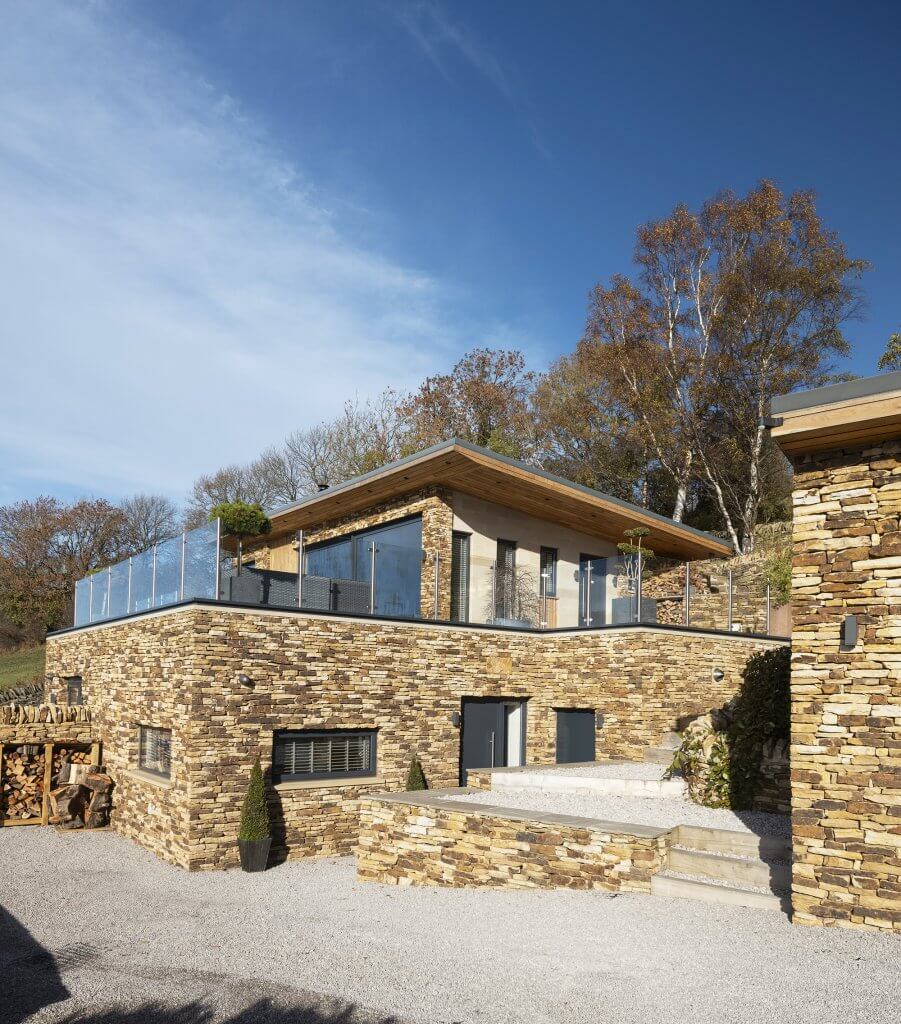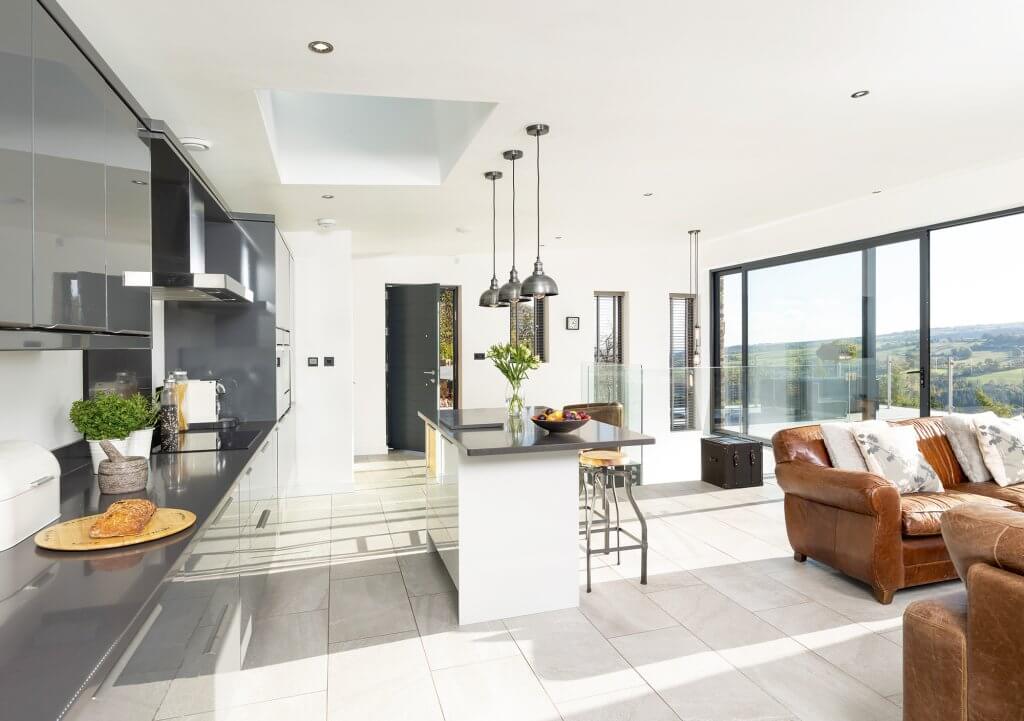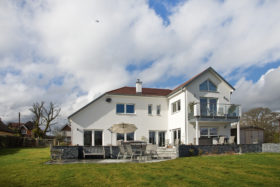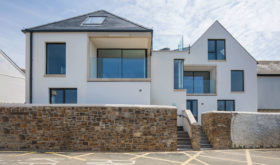

It’s not often plots of land – or houses generally, for that matter – come up for sale in the village of Bolsterstone, especially on Sunny Bank Road.
Along the mile-and-a-half stretch, every property is unique. Yet all share one outstanding feature: the stunning view overlooking the valley towards Broomhead reservoir.
Not only that, the lane has its name for a reason. In the height of summer, the south-facing properties bask in sunlight right up until 10pm.
For first-time self builder Simon Wells, then, it was a dream come true when a rare opportunity to purchase a plot came up. “When I read this site was going up for auction, I couldn’t let it slip away,” explains Simon.
“I had been gazumped on a similar gem of land five years earlier, and was determined to win this bid. We lived in a charming barn conversion at the time, so my wife Nicola wasn’t overly keen to move at first. But when I showed her what the plot had to offer, with its amazing view and undoubted potential, she was happy to support my journey.”
The plot was due to be sold via sealed bids, but having caught wind of who the owner was – a local property developer – Simon tried a different approach.
Just days before the auction, he called the agent and asked how much it would cost to take the land off the market. At £200,000, the price was right and a deal agreed.
The owner still received offers via the sealed bidding process, some higher than Simon’s, but was true to his word and the transaction went ahead.
|
This home was nominated for the Build It Awards 2019! |
Simon was able to fund the purchase of the idyllic site through his life savings, while the sale of the couple’s existing home gave them a cash reserve to get the project started.
The family then rented a property local to the plot while they got underway with the planning stages.
For the design, the couple enlisted the help of James Norton at Robin Ashley Architects. Their brief was for a contemporary light-filled home that capitalised on the bank-side location.
James drew up initial sketches for a two-storey steel and concrete block structure with a vast amount of glazing. Simon was keen to clad the property in natural stone and fit oak ascia/soffit boards, as he felt this combination would blend seamlessly with the surroundings.
“The site wasn’t large, but it was big enough for a spacious modern property,” he says. “I had taken a huge risk in that the plot didn’t come with planning, however it already housed a dilapidated shack, so I knew we could find a way to work with the local authority to create something truly unique and sympathetic to the landscape.”

The couple’s striking glazed roof terrace offers unobstructed views of the valley and reservoir beyond
Nevertheless, Simon was expecting the planning process to be something of a minefield. He took the initiative to engage a planning expert to fight his corner and provide additional guidance, to add weight to the architect’s arguments.
“Hiring a consultant was well worth the money,” stresses Simon. “I couldn’t recommend it highly enough. He helped me obtain 98% of what I wanted and interpreted the rules and regulations for me in layman’s terms.”
After six months of negotiations, the plans were signed off, and building work commenced in April 2015. Due to the sloping topography, large parts of the site had to be excavated.
“As we realised how much had to be removed and the sheer stubbornness of the solid rock underneath, costs started to escalate,” says Simon. “We ended up with 130 truckloads of excavated stone, which I couldn’t give away for love nor money. In the end, I had to pay someone to remove it.”
Following several months of intensive digging, it was finally time to get the first phase of construction works underway, and the team set about pouring the waterproof concrete for the retaining walls.
Unfortunately, it was at this point that Simon encountered his first major setback. “One afternoon we received a visit from the manager of the concrete company,” he says. “It was then he dropped the bombshell that, due to an admin error in the sales office, only part of our concrete was waterproof. I couldn’t believe it!”

Full-height glazing helps to make the most of the views from the open-plan living area, while Italian porcelain tiles extend the couple’s living space out onto the patio
It transpired that only 70% of the concrete that had been delivered was to the correct waterproof spec, compromising the as-designed performance of the retaining wall.
The build came to a standstill for about three weeks while conversations were had and court action was threatened.
Eventually the company offered to pay Simon compensation of £25,000, which helped fund the insertion of water channels, soakaways and tanking systems to mitigate the error.
Originally, Simon hadn’t intended to get involved in running the project. Working long hours, he simply couldn’t afford the time – so instead he decided to appoint a main contractor to oversee the works.
“I was no construction expert back then,” says Simon, “but it soon became clear that the builder was completely out of his depth. Not only that, he had financial issues so I had to fund him entirely – putting extra strain on my cashflow.”
The solution lay in the great relationship Simon had struck up with the architect. “Together, we were able to manage the project ourselves,” he says. “James was extremely receptive to the evolution of the building’s design.”
With a client-architect team now at the helm, the scheme got back on track. Simon spent all the time he could researching tradespeople and suppliers, and requesting samples. The stone facade was a major feature of the building, so getting the right quality and a fair price was essential.
Simon found a local farmer in Bradfield who could offer stone from his farmland at £40 per tonne. This was delivered to site by tractor, ready for stonemason Simon Harrington
to begin the laborious, highly skilled task of cutting and finishing the walls by hand, which took 18 months.
Meanwhile, as project manager, Simon plunged himself into the task of sourcing suppliers and negotiating rates.
As well as dealing with all the trades, he faced the arduous task of making arrangements with utility providers. “We needed a telegraph pole moved to a boundary wall – but, of course, getting through to the right person proved next to impossible,” he says.
“Eventually, having paid £1,000 for the privilege of having this pole relocated, I found that the only way to make any real progress was to speak to the lads who came to the site. Communication from these providers is diabolical, so I’d advise all potential self builders that they should be prepared to have their patience tested.”
The plot was sold off the mains gas grid, so Simon explored alternative heating methods from the outset. Due to space constraints, a ground source heat pump was out of the question. Planning constraints on the roof design meant solar thermal wasn’t practical for hot water production, either.
So instead the property was designed to run off an air source heat pump and woodburner, with underfloor heating as the emitter and a mechanical ventilation and heat recovery (MVHR) system to recycle warmth. This combination would meet all the family’s needs while reducing their long-term environmental impact and costs.
The house was oriented so to make the most of the warmth and light, with the main south-facing living space contained on the upper storey. The rear wall here is made up almost entirely of glazed doors, which not only encourage solar gain but also provide outstanding panoramic views.
“When the large sliding door is opened up to the decked patio, our living space immediately doubles in size,” says Simon. “I chose to use the same Italian porcelain tiles indoors and out here, so there’s no distinction between the zones.”
Combining a fabric first approach with well-specified renewable tech has proved a great success for conserving energy. “By integrating these efficient heat sources, passive solar design, high levels of insulation and MVHR, we have found our bills are extremely low compared to previous properties we’ve owned,” Simon continues.
“We receive £240 per quarter through the Renewable Heat Incentive scheme, too. What’s more, we rarely need to light the house in the day time, but if we do all our fittings use low-voltage LED lamps.”
Although the project went around £80,000 over budget, the results are spectacular. The concept has been beautifully realised and the quality of the finish is just as spectacular as the “damn fine view” beyond, as it was often referred to amongst the team on site.
Towards the end of the scheme, Simon found a few cost-effective solutions to rein in some of the spending. “I originally wanted a resin drive, for instance, but it would have cost me up to £25,000,” he says.
“I worked with the stonemason to devise a system using glass sand, a weed control membrane, interlocking grids and limestone chippings that came in at just £3,500. It was a huge saving that made up for the extra costs we incurred during the excavation phase.”
The overall effect of the building and its landscaping show how committed the team was to blending the house – now known as Dam View – in with its natural surroundings.
From the fibreglass green roof system to the glazed balustrades, each element was carefully considered. Even the leftover space at the back of the property has been creatively transformed into an allotment for neighbours to use (provided they share the product, of course).
The internal finish is just as remarkable. Rooflights dotted throughout both levels enhance the home’s brightness, while a minimalistic approach to decor gives instant modern appeal.
Downstairs there’s a plant room, L-shaped utility, store, study, bathroom and three sizeable, well thought-out bedrooms (including a master ensuite). Daughter Bailey’s room benefits
from a walk-in wardrobe that’s been plumbed out to cater for an ensuite, should it be needed in the future.
In testament to how well the house responds to the unique nature of the site, the project won the residential category in the Sheffield Design Awards. “Being recognised in this way makes all those thousands of painstaking decisions worthwhile,” says Simon.
“We had an incredible team who worked hard to pull this off, and I’m very proud. Would I do it again? Maybe when I’m semi-retired: a scheme of this scale demands a lot from you, and I think it’s important to be able to give it most if not all your attention.”

